Let’s continue our exploration of Anavil foodways with our special menu for Noli Nom – Vardu, Juwar no Rotlo, ane Luneli Kakdi.
But first a little background on Noli Nom. The holy month of Shravan brings the onset of festivities throughout India, with many regional variations. In Gujarat, Noli Nom is celebrated on the 9th day of the month (August 6th this year) by women to protect their children and to pray for their well-being.
All over Gujarat, women dress in bright, festive clothes and worship Nolio (mongoose). For this rather elaborate pooja, a nolio is made from juwar flour, and its eyes are made from desi vaal beans (aka butter beans or field beans). It is then covered with kanku (red turmeric powder) and robed in a saffron-colored cloth or the petals of marigold flowers. Diyas made from juwar flour are lit during the pooja to symbolize the triumph of light over evil. The eyes of the nolio are painted with kajal, also to ward off evil and the nolio is bathed in milk.
This ritual has its basis in folklore. There are various long and short versions of this story, but here’s the short and much less gory version, as told to me by my aunt Akshayafoi. One day a woman leaves her infant child asleep in its cradle to get water from the village well, in the care of a pet mongoose. As she returns home, she sees the mongoose all covered in blood. She assumes the mongoose killed her son so in anger, she throws the pot full of water at the mongoose which kills him. As she enters her house, she discovers a dead snake near her safe and sound infant, still asleep like an angel. She realizes that the mongoose fought with the snake to protect her child and deeply regrets her actions. From that day onwards, she starts worshiping ‘nolio’, and lo and behold, we have the Noli Nom festival.
Childless couples also celebrate Noli Nom as a vrat. It is said that if they fast all day, break the fast with the Noli Nom pooja and eat the Vardu as prasad, they will be blessed with a child. Noli nom also coincides with the annual harvest of kathol (beans), so another reason to offer a prayer to nolio is to ask for his help to protect the harvest from rats.
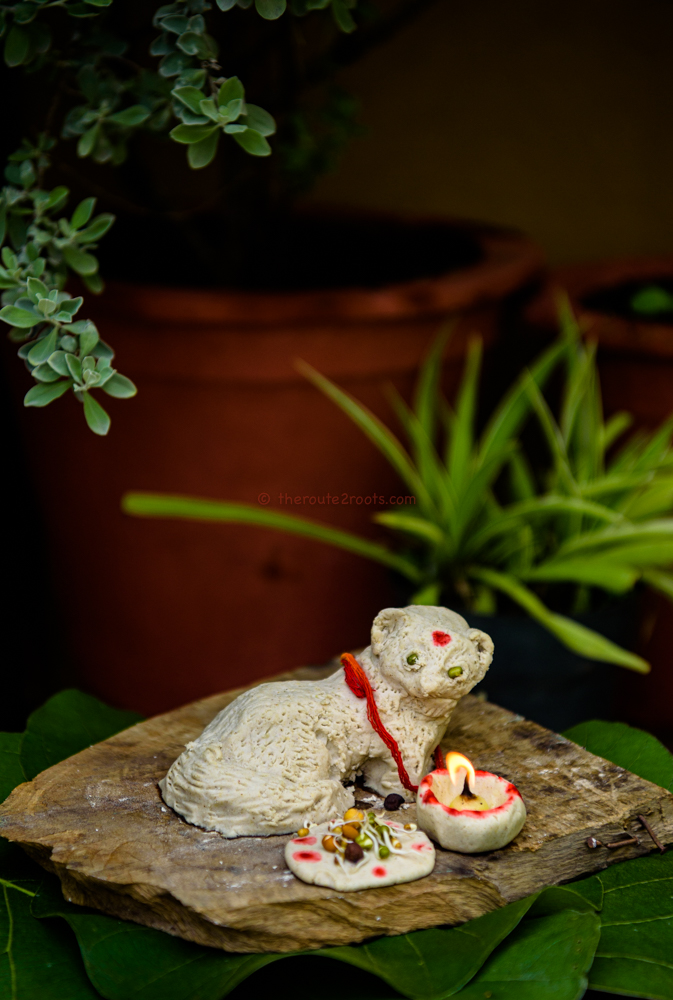
Now let’s come back to the delicious food cooked to celebrate this day. Vardu is a rather simple preparation, typically made with up to nine varieties of sprouted beans. Beans for Noli Nom are common across Gujarat but prepared in this particular way by Anavils. As my mom recalls, Anavil Samaj in Baroda for years held an annual vardu and rotlo competition, a popular event amongst the local Anavil community. And my aunt Geetafoi shares that nowadays, local grocery stores sell these beans as a ready mix all over Gujarat.
Luneli kakdi is another unique Anavil preparation, a side dish made with desi or heirloom variety of cucumber. What is Luneli, you might ask? Lunvanu is the process of massaging and goading all the juices out of the cucumber. The top edge is removed, and the kakdi is slit lengthwise into 4 almost till the bottom, so it stays as one piece. This is done using the sharp edge of a steel plate as knives cannot used on Noli Nom. Then it is gently massaged after stuffing the kakdi with pieces of green chilli, rock salt and lemon juice, which makes the kakdi soft and juicy and all the delicious flavors get melded. This process is much like ‘golo’ing a whole mango to make the pulp into juice before you suck it out of the mango itself, a common and traditional way to enjoy mangoes in India during peak season.
But I digress.On Noli Nom, women gather with friends, family, neighbors to celebrate, do the pooja, and enjoy these delicacies on Noli Nom. The rotlo and vardu are eaten with long slices of luneli kakdi. You may also find safed makhan, jaggery, a whole pickled mango called panichu and milk on the plate. My aunt Malvikafoi recalls how she marveled at how her foi sasu (aunt-in-law) would invite 30 women and make almost paper thin juwar rotlas for all.
The recipes below are presented by my mother, as learnt from my paternal grandmother and perfected by her expert hands and palette. These recipes and stories wouldn’t be possible without the collective wisdom of my mom, Rekha Desai, and all my paternal aunts – in particular Akshayafoi, Malvikafoi, and Geetafoi for this post. They are tested and beautifully photographed by Sheetal, to whom we owe lots of gratitude for giving Anavil micro cuisine a voice. And gratitude to all of you , following this blog, for reading this post, trying our recipes and sharing your comments and wisdom.
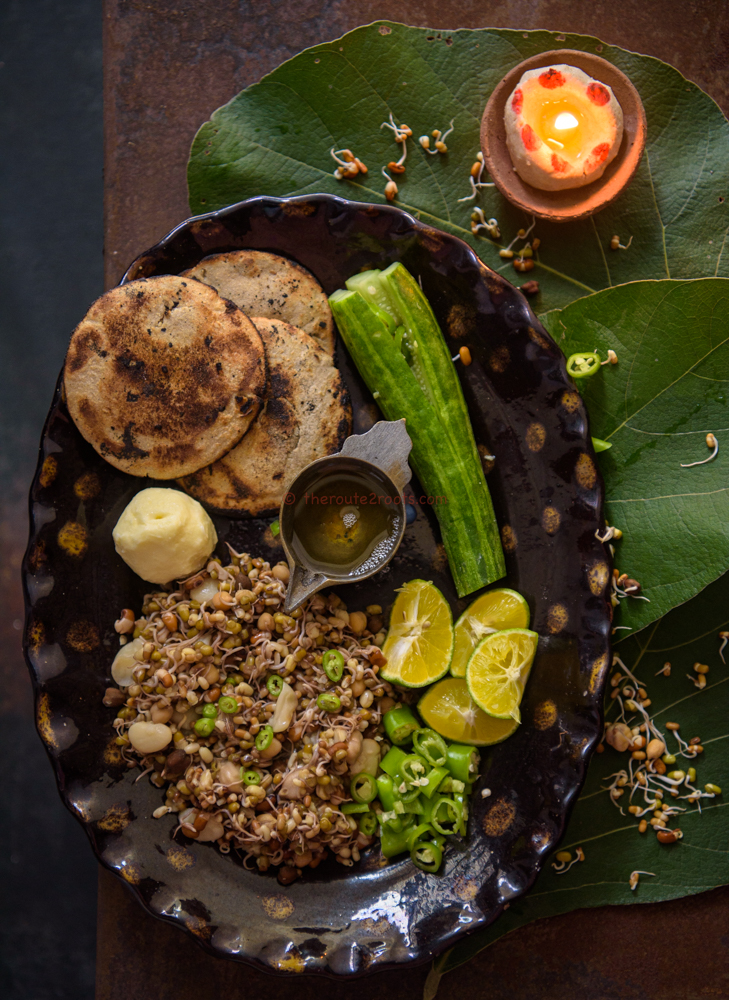
Noli Nom nu Vardu, Luneli Kakdi
Ingredients
- 1 cup moong beans
- 1 cup moth beans
- 1/4 cup desi chana
- 1/4 cup whole toor
- 1/4 cup suka vatana/ dry matar
- 1/4 cup kabuli chana
- 1/4 cup vaal/fava beans
- 1/4 cup desi chawli beans
- 1/8 cup chola/lobiya beans
- few green chilies
- some lemon wedges
- sesame oil
- Desi Cucumber
- salt to taste
Instructions
To prepare the sprouts, wash and soak moong, moth and desi chawli beans in one bowl and they rest of the beans in another bowl. Soak the pulses for 8-10 hours.
After the pulses have soaked, drain the water and place them in separate colanders to sprout. Depending on the weather, it should take 2 to 3 days for the beans to sprout. Chana, val take a little longer, so ensure they are dry and well ventilated or else they being to smell unpleasant.
On the day of Noli Nom, cook the sprouts in a pressure cooker. I preferred to cook them separately as moong, moth and chawli beans are quick to cook. Care should be taken not to turn them mushy. While cooking the sprouts, add salt.
Now to prepare luneli kakdi, take desi cucumber (one that is short and fat). Slit the cucumber lengthwise into four all the way but not completely (like you would when preparing Bharva subzi) to the end. The other end of the cucumber has to remain intact. Stuff the cucumber with a mixture of some finely chopped, salt and lemon juice. Now massage the cucumber to help it release its juices and also to allow it absorb the flavours of the green chili mixture.
Serve the Vardu (yes, just boiled) in a bowl with lemon wedges, chopped green chillies and some sesame oil.
The Vardu is enjoyed with jowar rotla, luneli kakdi/cucumber and some white butter on the side.


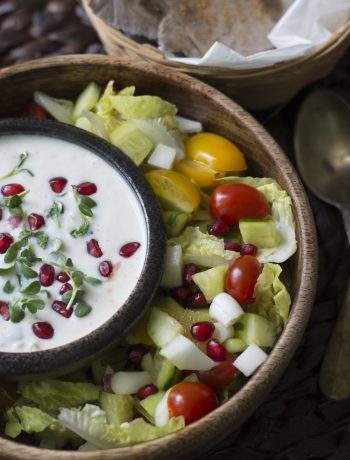
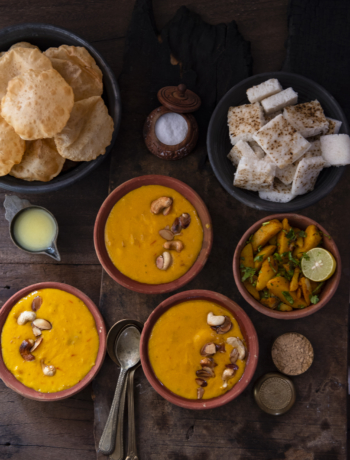
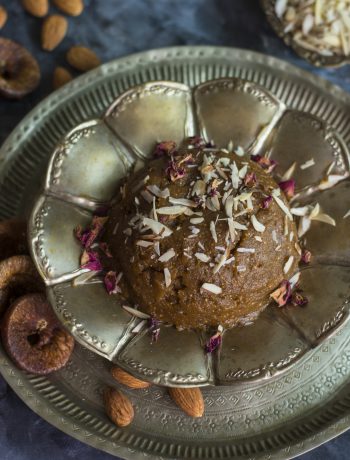
2 Comments
Mita Shah
January 24, 2023 at 1:00 amYou have done fabulous job of recipe and some specific stories regarding it.
Sheetal
February 27, 2023 at 9:32 amThank you so much !